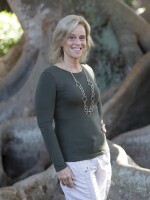Marie Selby Botanical Gardens has big ideas for the renovation of its 15-acre site on Sarasota's Bayfront.
Their 10-year master site plan includes a vertical "sky" garden, a cutting edge plant research center, parking garage and a rooftop restaurant. The plan, which is estimated to cost $67 million, will include infrastructure improvements aimed at keeping Selby's living collections out of flood zones into secure structures using green technology.
But the transformation is about more than just redevelopment.
Since the 2015 arrival of new CEO Jennifer Rominiecki, Sarasotans have been watching their garden grow. Visitation, membership and annual revenue are all up since new leadership repositioned Selby Gardens as a "living museum."
As the botanical garden goes through the city’s development review process, they've launched their third installment of a series connecting nature and the arts.
The exhibit follows attendance-breaking interdisciplinary exhibits of French painter Marc Chagall and pop art pioneer Andy Warhol. This time around, Selby is focusing on artist Paul Gauguin, best known for Tahitian motifs adopted during his self-imposed exile in French Polynesia.
"We’re here in this very cultivated paradise, a paradise that in a way Gauguin might be said to have curated in his own imagery," said Carol Ockman, a professor of art history and the curator of Selby's new show, "Gauguin: Voyage to Paradise."
A key figure in the Parisian avant-garde, the artist is perhaps best known as a painter but he worked in a wide range of media. Ockman says our understanding of Gauguin is heavily influenced by the mythic persona he created for himself as a self-described savage and outsider.
"The artist as somehow misunderstood and tormented,” she said. “That develops even more in the late 19th century with personae like Gauguin and Van Gogh. So there's a kind of really big business in myth making."
To some, Gauguin is one of modern art’s great bohemians. To others, he is a cultural imperialist who imposed western stereotypes on his subjects.

Undisputed however, is his position as a pioneer of modernism. His vibrant colors, flattened surfaces and straight lines had a huge impact on artists like Pablo Picasso and Henri Matisse.
Inside Selby's Museum of Botany and Arts are photographs, postcards and maps from Gauguin’s travels to French Polynesia along with 10 of his woodcut prints and lithographs created on his journeys to Brittany, Martinique and Tahiti.
Ockman says Gauguin was drawn to woodcut printmaking because it allowed for simple and direct expression.
“It was an arduous process that involves kind of gouging into the wood which is intractable of course,” she said. “It permits a simpler kind of art that was closer to nature."
In his work and his travels, Gauguin was constantly searching for a place beyond the reach of industrial civilization. He never found it, but Selby Gardens recreates his vision of a utopian paradise with living displays throughout the gardens.
In the glasshouse conservatory, visitors will see a circle of red-colored bromeliads suggesting a Polynesian fire pit and wood canoes cascading with flowering plants.
Angel Lara, a director of horticulture at Selby Gardens says one of the hardest design challenges was figuring out how to best mimic Tahiti's mountain region.
"Florida is flat, so there's no topography whatsoever,” he said. “So we created this Tahitian scenery and it’s basically a vinyl wrap on the glass of the conservatory that sort of makes you feel like you're within this mountain range."

The floor to ceiling wrap leads to lush green vegetation. Visitors then walk a path dotted with tiki masks and purple orchids potted in coconut shells.
Orchids were central to the founding goals of Selby Gardens. Its leaders say their master plan includes strengthening its position as a leader in the study of those plants.
They hope to go before Sarasota's Planning Board in May and the City Commission in June. If the plan is approved, Selby Gardens aims to break ground on the first phase of their renovation by the end of the year.







